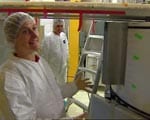Oscar Pistorius will be the first amputee to compete in the Olympics. Here’s a look at the mechanics of how he runs.
Book a live interview

To book a live or taped interview with Peter Weyand in the SMU News Broadcast Studio call SMU News at 214-768-7650 or email news@smu.edu. |
Related links
- Peter Weyand
- Journal of Applied Physiology: “The biological limits to running speed are imposed from the ground up”
- Part 1: Clarifications of the history of the case
- Part 2: The science of Oscar Pistorius’ advantage
- Annette Caldwell Simmons School of Education & Human Development
More SMU Research news
Discovery News has written a comprehensive piece on the running mechanics of double-amputee South African sprinter Oscar Pistorius, the first amputee to compete in the Olympics.
The July 20 article “How Olympic ‘Blade Runner’ Sprints Without Feet” quotes SMU’s Peter Weyand, an expert in human locomotion.
Controversy has swirled around Pistorius as the debate continues over the scientific advantage he enjoys as a result of his high-tech, carbon fiber artificial legs. Weyand helped lead a team of scientists who are experts in biomechanics and physiology in conducting experiments on Pistorius and the mechanics of his racing ability.
Weyand is widely quoted in the press for his expertise on human speed. He is an SMU associate professor of applied physiology and biomechanics in the Annette Caldwell Simmons School of Education & Human Development.
EXCERPT:
By Sheila Eldred
Discovery News
When the start gun goes off for the individual 400 and 4X400 relay at the 2012 London Olympics, double-amputee sprinter Oscar Pistorius, the man known as the Blade Runner, will spring out of the blocks with the world’s best able-bodied athletes. It marks the first time an amputee will compete in the Olympics.
Pistorius will be wearing carbon-fiber prosthetics designed for sprinting. While the debate over whether his flex-foot Cheetahs makes it harder or easier for him to sprint continues, there’s no doubt that the way his body covers 400 meters is different from his competitors.
As the athletes explode from their starting blocks, the South African born without fibulas will likely get a slower start. Because he can’t flex an ankle or stiffen a leg, it takes slightly longer for Pistorius to start. As the athletes gain an upright position, however, Pistorius will be able to reposition his legs much more quickly than his competitors. It’s that repositioning speed that’s been the point of contention of much of the debate.
In 2008, the International Association of Athletics Federations, track and field’s governing body, banned Pistorius from competing against able-bodied competitors, deeming his blades an advantage.
Pistorius went to Rice University in Houston for what he hoped would be definitive testing that would prove he had no advantage. And at first, that appeared to be the case: using some of the data from the research, published in the Journal of Applied Physiology, the Court of Arbitration for Sport overturned the ban.
But later, two of the scientists pointed to key findings — the repositioning data — that they believe make up at least a 7-second difference in the 400-meter dash. Researchers Peter Weyand, an exercise physiologist at Southern Methodist University, and Matt Bundle, an assistant professor at the University of Montana, presented their case in a point-counterpoint article in the Journal of Applied Physiology in 2009.
The reason the data is so telling, says Weyand, is not just that it shows an advantage; it’s that the comparison between Pistorius and able-bodied world class sprinters is off the charts. (Weyand and Bundle released a statement that explains their science, hoping to clear up misconceptions.)
“With the most generous assumptions, he still comes out seven seconds ahead in the 400,” Weyand said. “He’s a below-average high school runner without those limbs. A lot of people don’t want to hear that.” (…)
SMU is a nationally ranked private university in Dallas founded 100 years ago. Today, SMU enrolls nearly 11,000 students who benefit from the academic opportunities and international reach of seven degree-granting schools. For more information see www.smu.edu.
SMU has an uplink facility located on campus for live TV, radio, or online interviews. To speak with an SMU expert or book an SMU guest in the studio, call SMU News & Communications at 214-768-7650.
By Margaret Allen
Senior research writer, SMU Public Affairs
View Archive →
 Observed! SMU’s LHC physicists confirm Higgs ‘God particle’
Observed! SMU’s LHC physicists confirm Higgs ‘God particle’ DOE Award: advancing SMU’s link to the God particle
DOE Award: advancing SMU’s link to the God particle Ancient tree-ring records from southwest U.S. suggest today’s megafires are truly unusual
Ancient tree-ring records from southwest U.S. suggest today’s megafires are truly unusual Human diabetes has new research tool: Overfed fruit flies that develop insulin resistance
Human diabetes has new research tool: Overfed fruit flies that develop insulin resistance Modeling the human protein in search of cancer treatment: SMU Researcher Q&A
Modeling the human protein in search of cancer treatment: SMU Researcher Q&A Middle school boys who are reluctant readers value reading more after using e-readers
Middle school boys who are reluctant readers value reading more after using e-readers Dark matter search may turn up evidence of WIMPS: SMU Researcher Q&A
Dark matter search may turn up evidence of WIMPS: SMU Researcher Q&A Unconventional geothermal techniques a potential game changer for U.S. energy policy
Unconventional geothermal techniques a potential game changer for U.S. energy policy